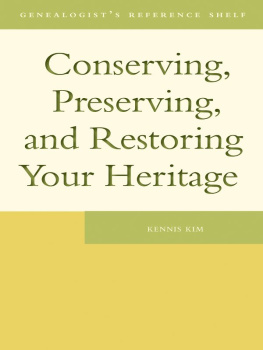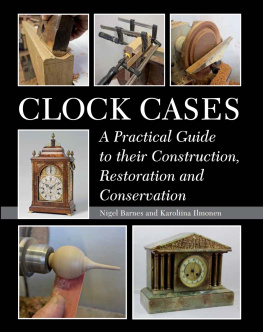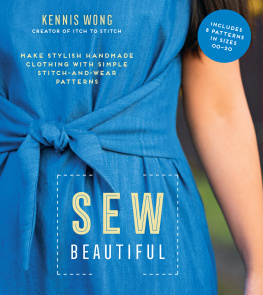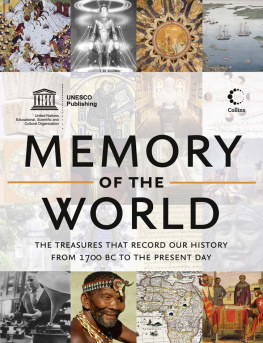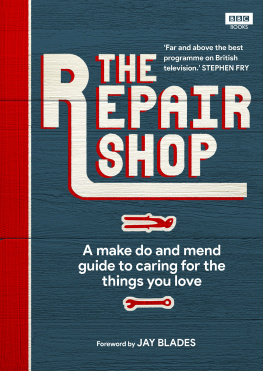
Conserving,
Preserving,
and Restoring
Your Heritage
GENEALOGISTS REFERENCE SHELF
Conserving,
Preserving,
and Restoring
Your Heritage
KENNIS KIM

Copyright Kennis Kim, 2010
All rights reserved. No part of this ullication may be reproduced, stored in a retrieval system, or transmitted in any form or by any means, electronic, mechanical, photocopying, recording, or otherwise (except for brief passages for purposes of review) without the prior permission of Dundurn Press and the Ontario Genealogical Society. Permission to photocopy should be requested from Access Copyright.
Editor: Ruth Chernia
Proofreader: Nicole Chaplin
Designer: Jennifer Scott
Printer: Transcontinental
Library and Archives Canada Cataloguing in ullication
Kim, Kennis
Conserving, preserving, and restoring your heritage : a professionals advice / by Kennis Kim.
Co-ullished by the Ontario Genealogical Society.
Includes bibliographical references.
ISBN 978-1-55488-462-9
1. Material culture--Conservation and restoration. 2. Antiquities--Collection and preservation. I. Ontario Genealogical Society II. Title.
AM313.K54 2010 02.88 C2009-907211-4
1 2 3 4 5 14 13 12 11 10

We acknowledge the support of the Canada Council for the Arts and the Ontario Arts Council for our ullishing program. We also acknowledge the financial support of the Government ofCanada through the Book ullishing Industry Development Program and The Association forthe Export of Canadian Books, and the Government of Ontario through the Ontario Bookullishers Tax Credit program, and the Ontario Media Development Corporation.
Care has been taken to trace the ownership of copyright material used in this book. The author and the ullisher welcome any information enabling them to rectify any references or credits in subsequent editions.
J. Kirk Howard, President
Printed and bound in Canada.
www.dundurn.com
Ontario Genealogical Society
Suite 102, 40 Orchard View Boulevard
Toronto, Ontario, Canada M4R 1B9
tel. (416) 489-0734 fax. (416) 489-9803
provoffice@ogs.on.ca www.ogs.on.ca
Dundurn Press
3 Church Street, Suite 500
Toronto, Ontario, Canada
M5E 1M2 | Gazelle Book Services Limited
White Cross Mills
High Town, Lancaster, England
LA1 4XS | Dundurn Press
2250 Military Road
Tonawanda, NY
U.S.A. 14150 |
CONTENTS
Appendices
History surrounds us in museums, in our communities, and in our homes. Whether objects were bought, found, or inherited, these artifacts offer glimpses into the past a time, place, event, or person we wish to remember and share with the future.
As custodians of pieces of our history, we are faced with how to maintain these items. Our family history may be held in documents, photographs, books, clothing, or textiles, and sometimes complete collections of items such as coins, trading cards, or stamps. We may have little knowledge of the artifacts we hold except that they meant something to someone, and now we feel an obligation or desire to preserve them for future generations. How we choose to execute our stewardship over these items takes many forms depending on their use, importance, and condition. More importantly, how we care for the items may be determined by what we know and what we can do financially without causing additional damage and deterioration. This book will guide you through some basic preservation techniques and preventative conservation practices for artifacts commonly found in family collections.
Many new terms are introduced through the text to help give you a better understanding of preservation, conservation, and restoration of your family heirlooms. All of the terms in bold can be found in the glossary.
There are many resources to help with the initial sorting and evaluation of historic documents and artifacts, including Help! Ive Inherited an Attic Full of History by Althea Douglas, ullished by the Ontario Genealogical Society in 2003. Once youve determined what you have, its time to decide how youll care for these things. Before you do anything, you should document what you have both in a written format and photographically, if possible. An accession list of all your holdings, will help you to know what you have and where it is, and help you decide what you might do with it. An accession list, similar to an inventory, can be made using an index card for each item or in a list on paper or in your computer. Whatever method of compiling the information you use, always keep a hard copy in a safe place somewhere other than your home. Having an accession list and photographs of your items can be helpful in recovering stolen goods, filing insurance claims, and sharing information, images, or documents with others without jeopardizing the originals.
A basic accession list can be as simple as listing the items either in groups or individually. Include what it is, where it came from, and where its located in your home (see ). Additional information might include condition notes, value, if its insured, historic significance, supporting research, conservation reports, and any other information that may relate to the artifact. Photographs can be slides, prints, or digital files.
The decision to display, store, or continue to use an artifact should in part be based on the condition and structural stability of the object. If an item is stable and in good condition, you can prepare it at home for display or storage. However, if an item is damaged or fragile, it may be necessary to call a professional (see ). Choose the right professional for your artifacts by considering the type of items, their overall condition, and the intended use of the objects. Storage, use, display, or just ignoring things all have consequences.
CHAPTER 1
The Home Environment
What are conservation, restoration, and preservation?
Conservation is the examination, stabilization, reconstruction (restoration), and reduction of further deterioration (preservation) of an object. Conservation often includes:
Scientific analysis of the object and the materials used during fabrication,
Research into the structure and historic significance of an artifact, and
Determination of overall condition and stability of the artifact.
Restoration refers to the reconstruction of the aesthetic appearance of an object. This is a small part of the conservation process.
Preservation is another small part of the conservation process that focuses on treatments to retard further deterioration of an object.
The most we are able to do in our homes are preservation and some basic preventative conservation. To preserve the structural stability and to slow deterioration of objects, you must pay attention to the environment, including light, temperature, and relative humidity, as well as the methods of handling, displaying, and storing the object.
Environmental Concerns
Light
All light is a form of energy. When light energy is absorbed by an artifact, it causes chemical changes in the molecular structure of the object. Natural and artificial light can damage objects by fading colours, yellowing varnishes, bleaching paper, and weakening textiles.
Next page
